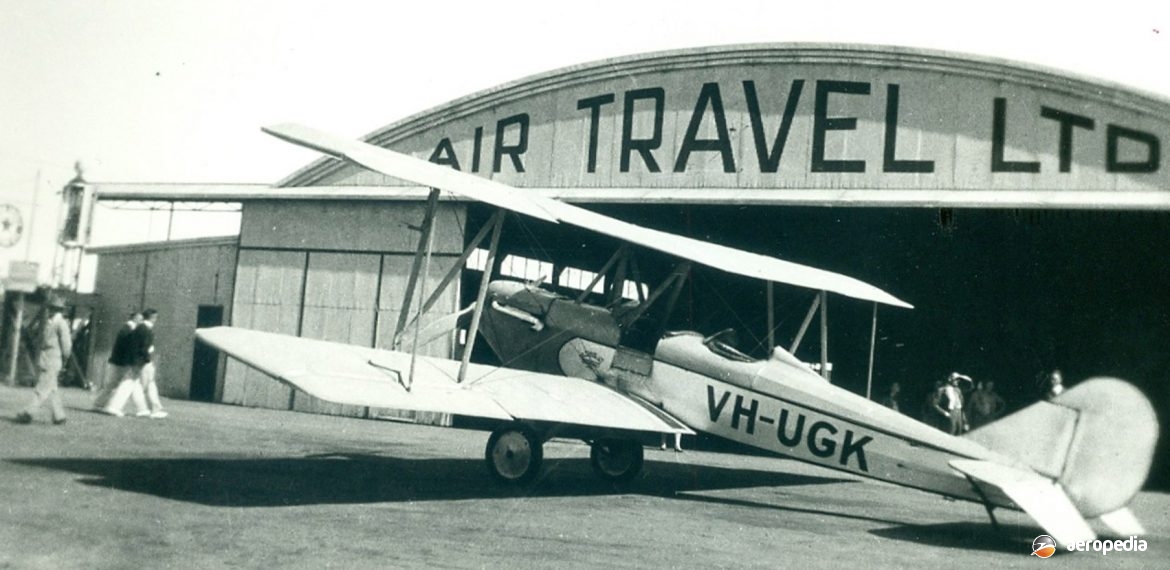Photograph:
Alexander Eaglerock VH-UGK (c/n 298) at Mascot, NSW in about 1928 (Frank Walters collection)
Country of origin:
United States of America
Description:
Three-seat light touring biplane
Power Plant:
One 67 kw (90 hp) Curtiss OX-5 eight-cylinder VEE liquid-cooled engine
Specifications:
- Wingspan [upper]: 10.97 m (36 ft)
- Wingspan [lower]: 11.58 m (38 ft)
- Chord [both wings]: 1.52 m (5 ft)
- Length: 7.61 m (24 ft 11 in)
- Height: 3.03 m (9 ft 11 in)
- Wing area: 33.44 m² (360 sq ft)
- Max speed: 148 km/h (92 mph)
- Cruising speed: 129 km/h (80 mph)
- Landing speed: 56 km/h (35 mph)
- Initial rate of climb: 148 m/min (485 ft/min)
- Ceiling: 3,505 m (11,500 ft)
- Range: 612 km (380 miles)
- Fuel capacity: 140 litres (31 Imp gals)
- Oil capacity: 18 litres (4 gals)
- Empty weight: 667 kg (1,470 lb)
- Loaded weight: 1,012 kg (2,230 lb)
History:
The Eaglerock series of light aircraft was manufactured by the Alexander Aircraft Co, a division of Alexander Industries of Denver, Colorado, USA. Late in 1924 the Alexander Film Co, headed by J Don Alexander, obtained an OX-5 Swallow biplane as a company aircraft in connection with promotion and sales activities. The aircraft became an asset to the company and, foreseeing the possible future of the aircraft industry, took the initiative and entered the aircraft construction field.
Production commenced at Englewood, Colorado but, after a fire in the dope shop which caused three large explosions, the Company moved to Colorado Springs in 1928. By this time there was a backlog of orders for more than 500 aircraft. Soon the Company was producing six variants of the Eaglerock, a smaller aircraft called the Flyabout, and a glider; and later produced the Bullet with a 75 kw (100 hp) Kinner radial engine or a 123 kw (165 hp) Wright engine.
The first model of the Eaglerock only had ailerons on one wing and no adjustable stabiliser. It was considered to be tail heavy. At that stage the services of Alan Mooney were obtained to correct the problems. As a result a new wing was built and flew well but it was found that near sea level, with any kind of wind, the aircraft would not land so the Company produced aircraft with different wings to suit the location where they were based.
The Company had more than 100 salesmen in the field offering film advertising and these were put to work also selling aircraft. There were 38 distributors and 150 dealerships set up to sell the aircraft. However, due to the Great Depression, the Alexander Aircraft Co, along with nearly 300 other aircraft manufacturers in the United States, went into liquidation after manufacturing more than 1,500 aircraft, although the film company survived.
The Eaglerock was designed and developed by Daniel Noonan. Equal span wings were fitted and connected to a normal centre-section cabane, but using a steel tube Warren-type truss for the interplane bracing in lieu of the normally used steel wire cables. The wings could be folded back, and the unusual bracing truss kept the wing panels in position whilst in the folded position. The fuselage framework was built up of steel tubing but was not welded, special clamps being fitted to make the joints. The framework was then lightly faired to shape and fabric covered.
The second Eaglerock design was introduced in January 1926 and had the folding wing mechanism deleted. It used what was then the newly developed Clark-Y aerofoil section in a high aspect ratio which provided a very efficient wing arrangement and gave good performance on the power available. A variety of engines was installed in addition to the Curtiss OX-5, these including the 90 kw (120 hp) Ryan Siemens nine-cylinder radial; Wright J-5 Whirlwind; Fairchild Caminez; a ten-cylinder Anzani; Curtiss OXX-6; Hispano, etc.
The OX-5 engine was the first American designed aircraft engine to enter production and some 12,000 examples were built. It was of V-8 configuration with a capacity of 503 cub in (8.2 litres) and weighed 177 kg (390 lb).
One example G-AUGK (c/n 298) was imported to this region. Powered by a 67 kw (90 hp) Curtiss OX-5 engine, it was assembled at Mascot, NSW and registered on 21 February 1928 to G N Mills and R King, who traded as Air Travel Ltd based in Sydney, NSW. It suffered its share of mishaps as, after only a month on the register, it crashed on take-off at Orange, NSW and had to undergo some repairs. The registration lapsed on 20 February 1933, and was changed on 31 August 1930 to VH-UGK, the Certificate of Airworthiness being renewed on 17 March 1933. However, it only survived until 7 October 1935 when it crashed at Greenwell Point, 14 km (9 miles) from Nowra, NSW. Only a couple survive in the United States.

